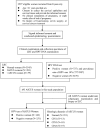Performance of Different Combination Models of High-Risk HPV Genotyping in Triaging Chinese Women With Atypical Squamous Cells of Undetermined Significance
- PMID: 31001472
- PMCID: PMC6456653
- DOI: 10.3389/fonc.2019.00202
Performance of Different Combination Models of High-Risk HPV Genotyping in Triaging Chinese Women With Atypical Squamous Cells of Undetermined Significance
Abstract
Objective: The purpose of this study was to evaluate the effect of different combination models of high-risk human papilloma viruses (HPV) genotyping in triaging Chinese women with atypical squamous cells of undetermined significance (ASCUS). Methods: We established a screening cohort of 3,997 Chinese women who underwent cervical cytology and HPV genotyping test. Women with ASCUS cytology underwent punch biopsy under colposcopy/endocervical curettage. The sensitivity, specificity, positive predictive value (PPV), and negative predictive value (NPV) of different combination models of HR-HPV genotyping calculated that cervical intraepithelial neoplasia 2 or higher (CIN2+) on histology were endpoints. Results: Of the full sample, 393 women had ASCUS. Among ASCUS women with a CIN2 lesion, the prevalence for HPV were 40.0% (type 16), 10.0% (type 18), 0.0% (type 33), 30.0% (type 52), 40.0% (type 58), and 30.0% (other nine types). For ASCUS women with a CIN3 lesion, the prevalence for HPV were 68.4% (type 16), 15.8% (type 18), 10.5% (type 33), 31.6% (type 52), 15.8% (type 58), and 36.8% (other nine types). Combination model including HPV16/18/33/52/58 for predicting CIN2+ lesion in women with ASCUS had relatively higher sensitivity [93.1% (78.0, 98.1)], specificity [75.8% (71.2, 79.9)], PPV [23.5% (16.7, 32.0)], and NPV [99.3% (97.4, 99.8)] than other combination models. Moreover, the referral rate of HPV16/18/33/52/58 (29.3%) was lower than HR-HPV (36.1%). Conclusions: The study demonstrates that specific HR-HPV types HPV16/18/33/52/58 may be an effective strategy in ASCUS triage. This improves the subsequent selection of ASCUS patients.
Keywords: atypical squamous cells of undetermined significance (ASCUS); cervical cancer; genotyping; human papilloma virus (HPV); triage.
Figures
Similar articles
-
[Clinical effect evaluation of high risk human papilloma virus E6/E7 mRNA in triaging women with atypical squamous cells of undetermined significance].Zhonghua Zhong Liu Za Zhi. 2021 Oct 23;43(10):1094-1099. doi: 10.3760/cma.j.cn112152-20190516-00311. Zhonghua Zhong Liu Za Zhi. 2021. PMID: 34695901 Chinese.
-
The Efficiency of Type-Specific High-Risk Human Papillomavirus Models in the Triage of Women with Atypical Squamous Cells of Undetermined Significance.Cancer Manag Res. 2020 Jul 1;12:5265-5275. doi: 10.2147/CMAR.S254330. eCollection 2020. Cancer Manag Res. 2020. PMID: 32669875 Free PMC article.
-
The effectiveness of HPV16 and HPV18 genotyping and cytology with different thresholds for the triage of human papillomavirus-based screening on self-collected samples.PLoS One. 2020 Jun 11;15(6):e0234518. doi: 10.1371/journal.pone.0234518. eCollection 2020. PLoS One. 2020. PMID: 32525936 Free PMC article.
-
Improving the performance of reflex Human Papilloma Virus (HPV) testing in triaging women with atypical squamous cells of undetermined significance (ASCUS): A restrospective study in a tertiary hospital in United Arab Emirates (UAE).Vaccine. 2016 Feb 3;34(6):823-30. doi: 10.1016/j.vaccine.2015.12.011. Epub 2015 Dec 30. Vaccine. 2016. PMID: 26747717
-
Evidence regarding human papillomavirus testing in secondary prevention of cervical cancer.Vaccine. 2012 Nov 20;30 Suppl 5:F88-99. doi: 10.1016/j.vaccine.2012.06.095. Vaccine. 2012. PMID: 23199969 Review.
Cited by
-
Comparative study of triage strategies for women with atypical squamous cells of undetermined significance in the post-vaccine era.Front Oncol. 2024 Oct 8;14:1416116. doi: 10.3389/fonc.2024.1416116. eCollection 2024. Front Oncol. 2024. PMID: 39439955 Free PMC article.
-
Analysis of the related factors of atypical squamous cells of undetermined significance (ASC-US) in cervical cytology of post-menopausal women.Front Cell Infect Microbiol. 2023 Feb 16;13:1123260. doi: 10.3389/fcimb.2023.1123260. eCollection 2023. Front Cell Infect Microbiol. 2023. PMID: 36875525 Free PMC article.
-
The Triage Effectiveness of an Extended High-Risk Human Papillomavirus Genotyping Assay for Women with Cytology Showing Atypical Squamous Cells of Undetermined Significance in China.Risk Manag Healthc Policy. 2020 Sep 24;13:1747-1756. doi: 10.2147/RMHP.S270265. eCollection 2020. Risk Manag Healthc Policy. 2020. PMID: 33061708 Free PMC article.
-
Efficient combination of Human Papillomavirus Genotyping for the triage of women with Atypical Squamous Cells of Undetermined Significance in Chinese rural population: A population-based study.J Cancer. 2021 Mar 14;12(10):2815-2824. doi: 10.7150/jca.55771. eCollection 2021. J Cancer. 2021. PMID: 33854582 Free PMC article.
References
-
- Boardman LA, Goldman DL, Cooper AS, Heber WW, Weitzen S. CIN in pregnancy: antepartum and postpartum cytology and histology. J Reprod Med. (2005) 50:13–8. - PubMed
LinkOut - more resources
Full Text Sources
Molecular Biology Databases


